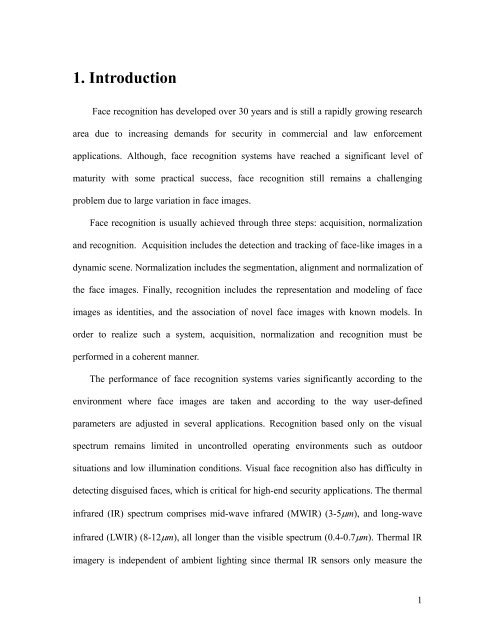Fusion of Visual and Thermal Face Recognition Techniques: A ...
Fusion of Visual and Thermal Face Recognition Techniques: A ...
Fusion of Visual and Thermal Face Recognition Techniques: A ...
Create successful ePaper yourself
Turn your PDF publications into a flip-book with our unique Google optimized e-Paper software.
1. Introduction<br />
<strong>Face</strong> recognition has developed over 30 years <strong>and</strong> is still a rapidly growing research<br />
area due to increasing dem<strong>and</strong>s for security in commercial <strong>and</strong> law enforcement<br />
applications. Although, face recognition systems have reached a significant level <strong>of</strong><br />
maturity with some practical success, face recognition still remains a challenging<br />
problem due to large variation in face images.<br />
<strong>Face</strong> recognition is usually achieved through three steps: acquisition, normalization<br />
<strong>and</strong> recognition. Acquisition includes the detection <strong>and</strong> tracking <strong>of</strong> face-like images in a<br />
dynamic scene. Normalization includes the segmentation, alignment <strong>and</strong> normalization <strong>of</strong><br />
the face images. Finally, recognition includes the representation <strong>and</strong> modeling <strong>of</strong> face<br />
images as identities, <strong>and</strong> the association <strong>of</strong> novel face images with known models. In<br />
order to realize such a system, acquisition, normalization <strong>and</strong> recognition must be<br />
performed in a coherent manner.<br />
The performance <strong>of</strong> face recognition systems varies significantly according to the<br />
environment where face images are taken <strong>and</strong> according to the way user-defined<br />
parameters are adjusted in several applications. <strong>Recognition</strong> based only on the visual<br />
spectrum remains limited in uncontrolled operating environments such as outdoor<br />
situations <strong>and</strong> low illumination conditions. <strong>Visual</strong> face recognition also has difficulty in<br />
detecting disguised faces, which is critical for high-end security applications. The thermal<br />
infrared (IR) spectrum comprises mid-wave infrared (MWIR) (3-5µm), <strong>and</strong> long-wave<br />
infrared (LWIR) (8-12µm), all longer than the visible spectrum (0.4-0.7µm). <strong>Thermal</strong> IR<br />
imagery is independent <strong>of</strong> ambient lighting since thermal IR sensors only measure the<br />
1
















